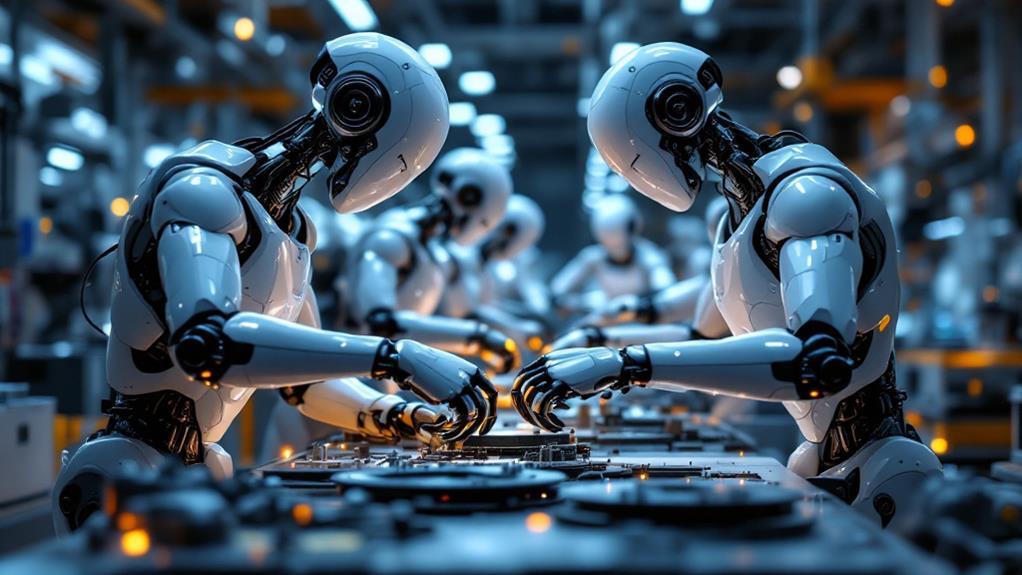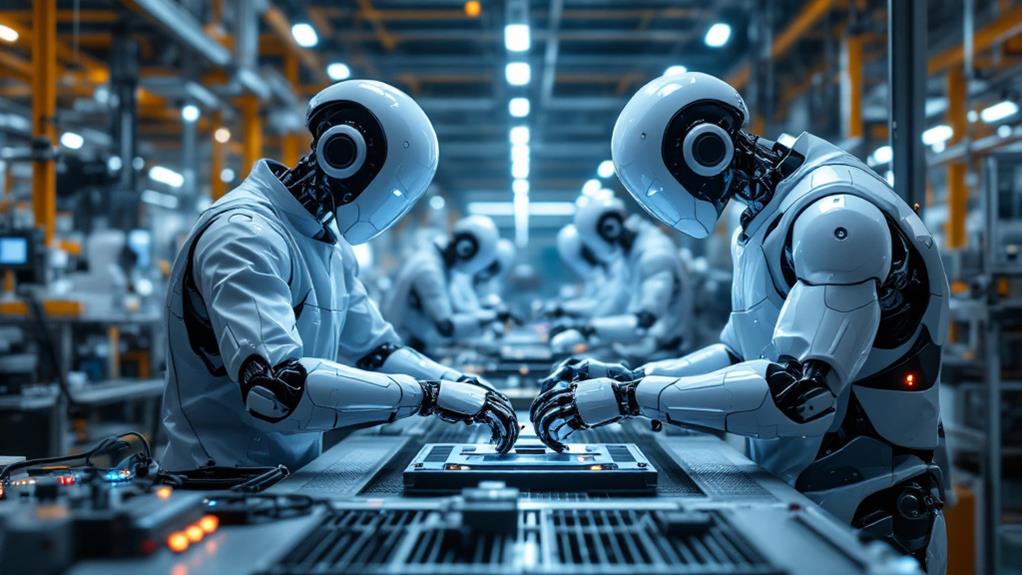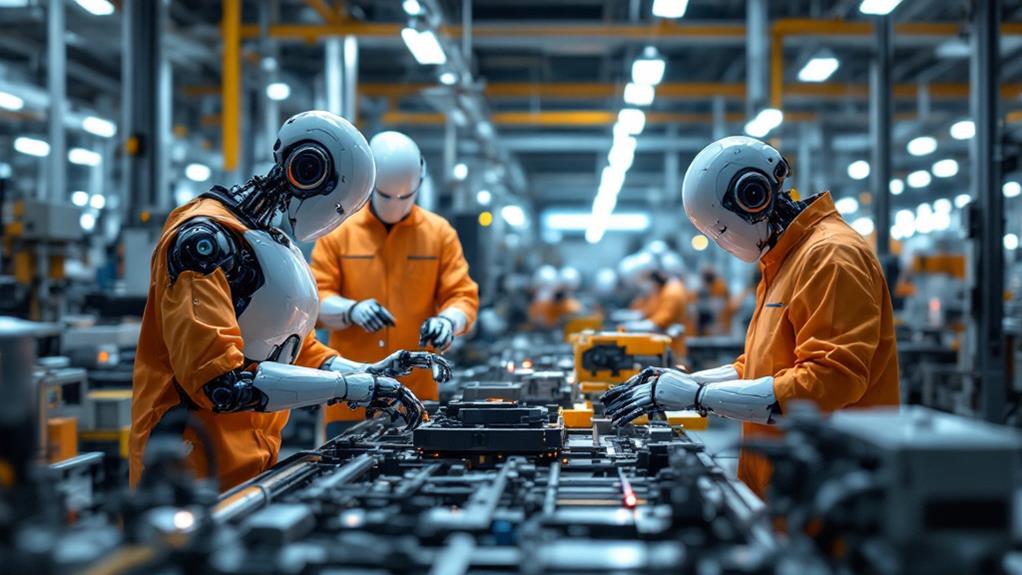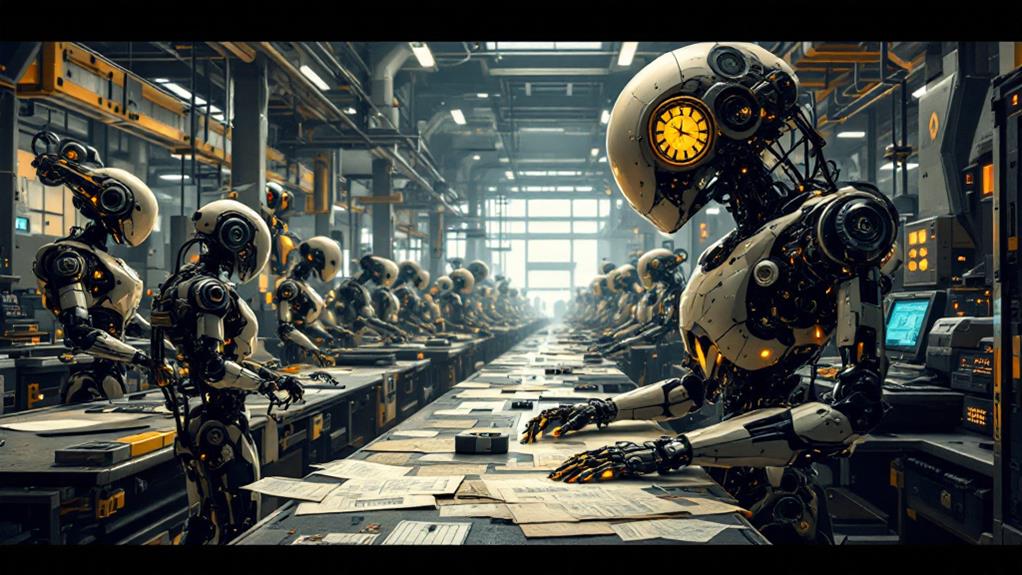What Is a Cobot? Understanding Collaborative Robots in Industry

You're likely curious about cobots, or collaborative robots, which are transforming industries by working alongside humans. Unlike traditional robots, cobots are equipped with cutting-edge safety features to detect human presence, ensuring a safe and productive environment. These robots streamline tasks in manufacturing, logistics, and healthcare, leading to cost savings and heightened efficiency. Cobots have user-friendly programming interfaces and lightweight designs for easy integration. Beyond just automating repetitive tasks, they improve job satisfaction by allowing you to focus on more complex duties. It's intriguing how cobots are raising operational standards across diverse sectors, wouldn't you agree?
Defining Collaborative Robots
Collaborative robots, often referred to as cobots, are steadily transforming the landscape of modern industry. As you explore the world of cobots, it's essential to understand what sets them apart. Unlike traditional industrial robots that operate in isolated areas, cobots are designed to work alongside humans, enhancing productivity without compromising safety. There are several cobot types, each tailored to specific tasks. For instance, some cobots focus on precise assembly work, while others are optimized for tasks like packaging or material handling. Understanding these different types helps you select the right cobot for your needs.
Safety standards are a vital aspect of cobot design. Unlike their traditional counterparts, cobots are equipped with advanced sensors and programming that allow them to detect human presence and adjust their actions accordingly. These built-in safety measures guarantee that cobots can operate safely in close proximity to humans, minimizing the risk of accidents. Adhering to international safety standards, such as ISO 10218 and ISO/TS 15066, cobots are rigorously tested to confirm they meet stringent safety requirements. By integrating cobots into your operations, you can enhance efficiency while maintaining a safe work environment.
Key Features of Cobots
Building on the understanding of cobots and their safety standards, let's examine the key features that make them indispensable in modern industry. Primarily and foremost is cobot safety, a critical aspect ensuring these machines work harmoniously alongside human workers. Unlike traditional robots, cobots are equipped with advanced sensors and algorithms that allow them to detect human presence and react accordingly. They can slow down or stop entirely when a person gets too close, greatly reducing the risk of accidents.
Another standout feature is programming flexibility. Cobots are designed to be user-friendly, allowing you to program them with ease. You won't need extensive technical knowledge to get started. Many cobots feature intuitive interfaces, sometimes even offering drag-and-drop programming or learning by demonstration. This means you can quickly adapt the cobot to different tasks without a lengthy setup process.
Cobots are also incredibly versatile, able to perform a wide range of tasks from assembly to packaging. Their lightweight and compact design means they can be easily integrated into existing production lines without major overhauls. This versatility, combined with their safety and programming flexibility, makes cobots a valuable asset in any industrial setting.
Benefits of Using Cobots

Thanks to their groundbreaking design and adaptability, cobots offer numerous benefits that revolutionize the modern workplace. One of the most notable advantages is cost savings. By integrating cobots, you can reduce labor costs and minimize errors, which directly impacts the bottom line. Cobots also elevate increased efficiency by working alongside humans to streamline repetitive tasks and optimize production processes. This collaboration allows your team to focus on more strategic, value-added activities, improving overall productivity.
In terms of workforce improvement, cobots empower employees by taking over mundane or physically demanding jobs. This not only enhances job satisfaction but also allows your team to engage in skill development. As employees learn to operate and program cobots, they gain valuable technical skills that can advance their careers.
Safety improvements are another vital benefit. Cobots are designed with advanced sensors and safety features, considerably reducing the risk of workplace accidents. They can detect human presence and adjust their operations to guarantee a safe working environment. Finally, cobots offer unparalleled operational flexibility. They can be easily reprogrammed and redeployed for different tasks, allowing your business to adapt quickly to changing demands without major disruptions.
Applications Across Industries
Cobots are transforming a wide range of industries with their versatile applications. In manufacturing, they elevate efficiency by working alongside humans, handling repetitive tasks like assembly and quality inspection. This allows you to focus on more complex activities, ultimately improving productivity.
In healthcare, cobots offer assistance by transporting medications and supplies or even aiding in surgeries. They help reduce human error, ensuring better patient care and safety. Logistics optimization is another area where cobots shine. They streamline warehouse operations by sorting packages and managing inventory, making the supply chain more efficient.
Agriculture sees innovation through cobots with tasks such as planting, harvesting, and monitoring crop health. Their precision helps increase yield and reduce waste, allowing you to manage resources better. In education, cobots serve as educational tools, teaching students programming and robotics, preparing the next generation for a tech-driven world.
Construction sites benefit from cobots too. They improve safety by handling heavy lifting and dangerous tasks, reducing the risk of injury for workers. Regardless of the industry, cobots are here to assist and innovate, making your operations smoother and more efficient.
Human-Robot Interaction

As cobots continue to transform diverse industries, understanding how humans and robots interact becomes increasingly significant. You need to evaluate human factors when integrating cobots into your workplace. It's essential to guarantee they complement human skills and improve productivity without causing discomfort or stress. Safety protocols are critical, as they prevent accidents and guarantee a secure environment for both humans and machines. Establishing clear guidelines helps everyone understand how to work safely alongside these robots.
Training requirements shouldn't be overlooked either. Providing thorough training guarantees your team feels confident and capable when using cobots. This not only improves user experience but also raises efficiency and morale. In addition, seamless workplace integration is a must. Cobots should fit naturally into your existing processes, improving rather than disrupting your operations.
You must also address ethical considerations, as they play a significant role in human-robot interaction. It's significant to evaluate the impact of cobots on employment and guarantee they're designed and used responsibly. Balancing these elements will help you create a harmonious and productive environment, where humans and robots work together effectively and safely.
Future Trends in Robotics
Looking ahead, the future of robotics promises transformative advancements that will reshape industries and daily life. You'll see autonomous systems becoming more sophisticated, taking on tasks previously regarded as too complex. Imagine robots not just assisting, but autonomously maneuvering through dynamic environments and making independent decisions. These advancements will drive efficiency and innovation across sectors like manufacturing, healthcare, and logistics.
However, with great power comes great responsibility. As robotics technology advances, robotic ethics will become increasingly significant. You need to contemplate the ethical implications of deploying autonomous systems, especially when they operate with minimal human oversight. Questions about data privacy, decision-making accountability, and the potential job displacement caused by automation will need your attention and understanding.
Furthermore, as you engage with these technologies, you'll be part of shaping the guidelines and policies that govern their use. It's essential to make certain that autonomous systems are developed and deployed in ways that prioritize safety, fairness, and transparency. By doing so, you'll help create a future where robotics not only enhances productivity but also improves societal well-being, guaranteeing a harmonious coexistence between humans and machines.



